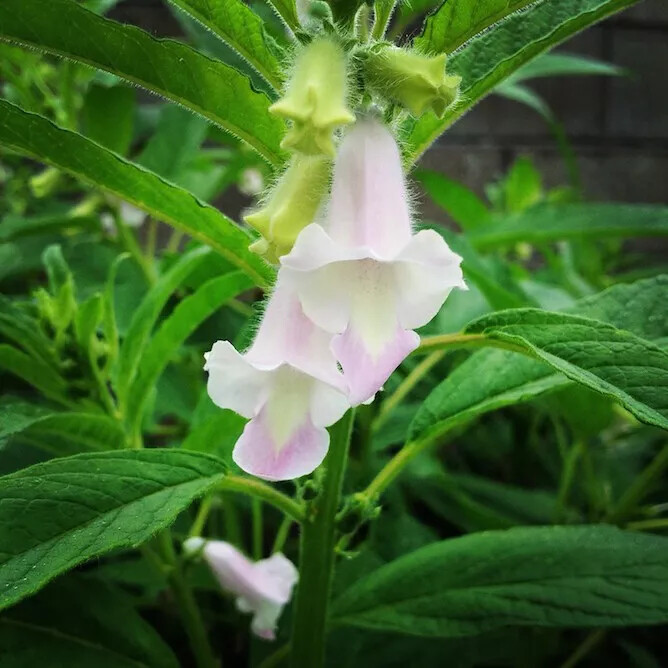Sesame plants produce the delicious, ubiquitous sesame seeds we see on bagels, in tahini, and as an essential ingredient in many foods. The seeds produced are tiny, but one seedpod can produce hundreds of seeds.
Sesame is known as an "oilseed crop" and is one of the oldest cultivated crops known to recorded human history. It has a high oil content, making it nutritionally dense. The rich, uniquely nutty flavor is recognizable in tahini paste, one of the most common products made from it. It is also used for many commercial baked goods including breads, cakes and cookies.
This plant is a tropical perennial native to Africa and India. It must have very hot, dry conditions for growing, making it something of a challenge for gardeners who don't live in the appropriate growing zones.
Sesame plants produce bell-shaped pendulous flowers that look a bit like foxgloves and may be white, purple, or blue. Bees love these flowers and the honey is very tasty and in high demand.
The plants grow up to three feet tall. The seeds vary in color depending in the variety and may be white, brown, red or buff colored.
The word "sesame" is derived from Latin, Greek and Semitic words that all mean "oil" or "liquid fat." Not only are they caloric, but they also contain fat, protein and carbohydrates, and several dietary minerals and B vitamins as well.
Scientific Name:
Sesamum indicum
Common Name:
Sesame
Plant Type:
Tropical
Mature Size:
3-4 feet
Sun Exposure:
Full sun
Soil Type:
Medium texture, well-drained
Soil pH:
Neutral, sweet (no salt)
Bloom Time:
Summer
Flower Color:
White, purple, blue
Hardiness Zones:
10 and above
Native Areas:
Sub-Saharan and North Africa, India
Toxicity:
Non-toxic

Sesame Plant Care
There are thousands of cultivars of sesame, probably because it's been a plant known to humans for over 5000 years.
Although these plants are generally tolerant of very poor growing conditions (thin soil, high heat, drought), the best crop yields occur in fertile, well-drained soil.
Light
Sesame plants need plenty of direct sunlight and they like warmth. Try to plant near a stone or brick wall for added heat production.
Soil
Sesame plants are very tolerant of different soil conditions, but good drainage is a necessity. A sandy, loamy soil is a good option. No fertilization is required and, in fact, should be discouraged.
Sesame cannot handle standing water or wet soils, or heavy clay soils, nor will it tolerate salty soil or salt air.
Water
While regular watering is important for germination and establishing young plants, sesame plants don't need much water.
It's best not to situate them near other plants that get watered regularly. Giving them their own raised bed or section of garden ensures appropriate moisture and low humidity.
Planting them alongside other drought-tolerant plants (like lavender, thyme or sedums) is a good idea. Do not use drip irrigation as this will drown the plants.
Temperature and Humidity
The sesame plant's ability to withstand hot dry desert conditions makes it a very valuable food crop for parts of the world troubled by drought.
Growing Sesame Plants from Seed
Sesame seeds should not be direct sown outdoors. Plant seeds indoors four to six weeks before the last frost date.
Lightly cover with soil-less planting mix. Keep moist until they germinate, then water once a week or so.
Sesame seeds germinate best at temperatures between 68 and 75 degrees. They are indeterminate plants, which means they will continue to bloom and set seed capsules over a long period in the summer, with peak flowering in July and early August.
Harvesting Seeds
Sesame seeds are very small, and drying them is very difficult. But they need to be dry for storage so they don't go rancid, which is a possibility due to their high oil content. Therefore it's necessary to make sure they dry out sufficiently on the plant inside the seed pod before harvesting them.
Sesame seeds ripen from the bottom of the plant upwards. The first flowers to appear are lower down. As the seed pods begin to split, which happens in late summer, cut the stems and lay them flat in a dry place. Hanging them will cause the seeds to fall out, but you can do it this way if you have a tray or bucket to catch the seeds.
The plant's leaves will darken as they dry and the pods will continue to split open. Then you may tap the stems and pods against the sides of a bucket to catch the seeds. Some enthusiasts toast the dried seeds before storing as this can help to preserve their flavor and prevent spoilage.